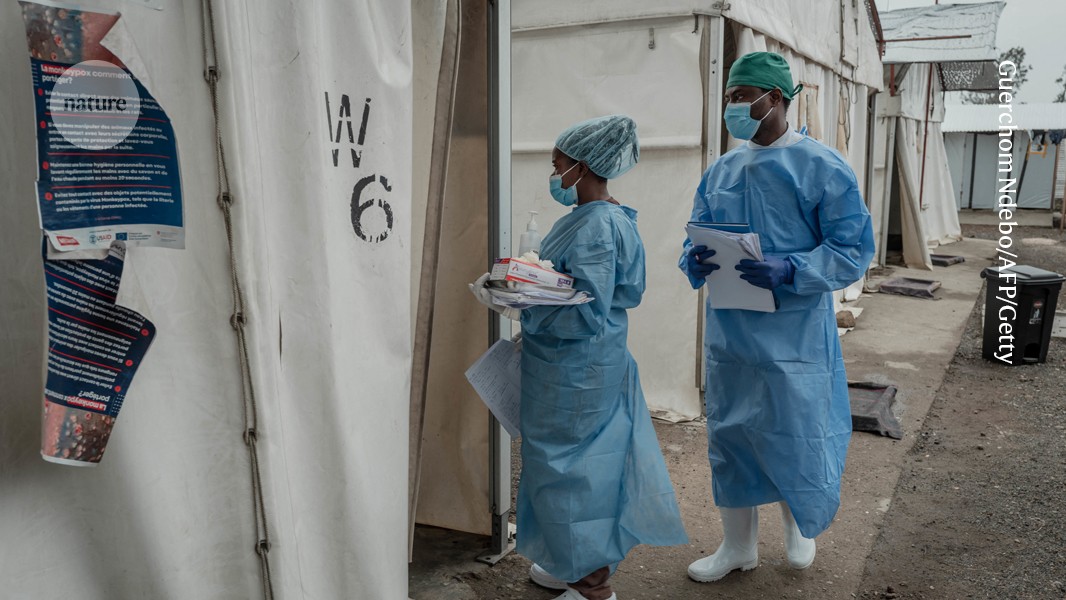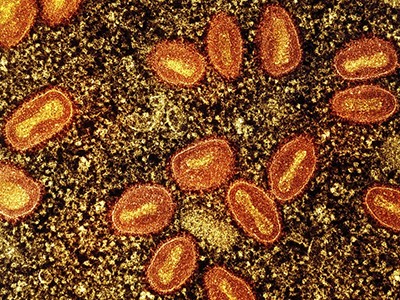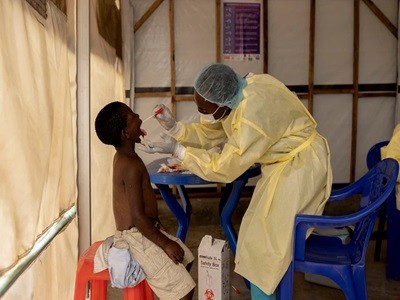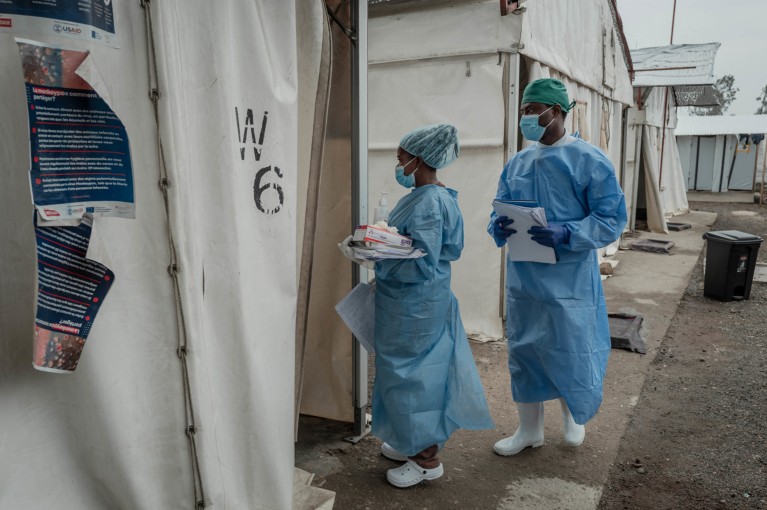
An mpox treatment centre north of Goma in the Democratic Republic of the Congo. More help with disease surveillance will bridge the gap between suspected and confirmed cases.Credit: Guerchom Ndebo/AFP/Getty
Before the World Health Organization (WHO) and the Africa Centres for Disease Control and Prevention (Africa CDC) declared the mpox outbreak in a growing number of African countries to be a public-health emergency in mid-August, there were fears that the experience of the COVID-19 pandemic would be ignored in this latest public-health crisis. The international community is now starting to get its act together, and some lessons are being applied. Vaccines are available and more can be made. Moreover, a funding facility has been established to buy and distribute them. But in other respects, all is not as it should be in the fight to bring mpox under control and safeguard the lives (and livelihoods) of millions of people in Africa.
First, African countries lack the resources to track the disease. This is why there’s a large mismatch between the number of suspected cases and those confirmed through laboratory tests. Second, vaccines need to quickly get to where they are needed most. This requires both access to funding and the international donor community to coordinate procurement and delivery with African nations. Third, mpox is a reminder that Africa severely needs its own vaccine manufacturing and regulatory infrastructure. In particular, the African Medicines Agency, a long-planned project to create a single medicines regulator for African countries, must quickly become a reality.
Mpox is caused by variants of the monkeypox virus, which was first identified in a human in the Democratic Republic of the Congo (DRC) in 1970. It spreads through close contact with someone who is infected, or by contact with materials contaminated with the virus. Mpox symptoms include characteristic lesions, high temperature, sore throat, cough and swollen lymph nodes.
A major mpox outbreak was declared in 2022, with cases mostly in the Americas and Europe, but that outbreak is now under control. The latest emergency is caused mainly by a virus lineage called clade Ib. As of 1 September, there had been some 20,000 laboratory-confirmed or suspected mpox cases this year. The overwhelming majority have been in the DRC, although neighbouring Burundi is now seeing a rise (see ‘Mpox rising’). Most people will recover after four weeks or less, but this is a potentially fatal disease, and four out of five mpox deaths this year have been in children.
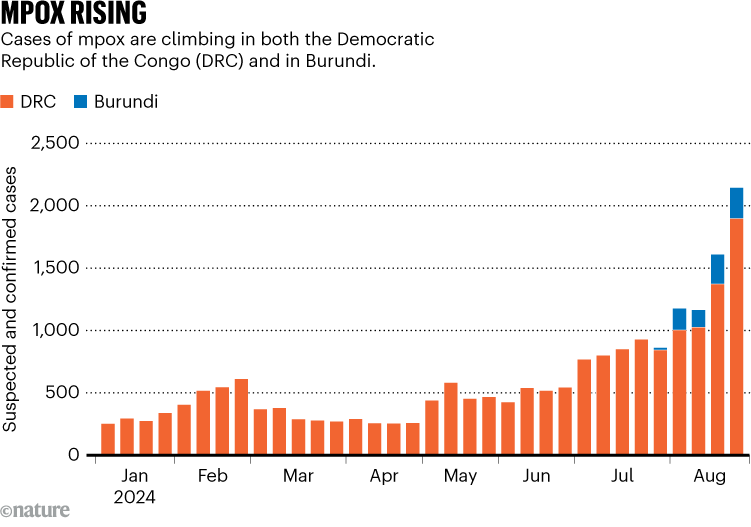
Source: WHO
A major problem is that the affected countries lack sufficient facilities to identify infected individuals, test them and then trace their contacts. It goes without saying that international aid donors absolutely must prioritize disease surveillance.
Pandemic lessons
What are some of the other relevant lessons from COVID-19 — those that are being applied and those that are not?
One important result of that pandemic is that there is money available for the poorest countries to tackle health emergencies, according to Gavi, the vaccine alliance. These countries now have access to a US$500-million fund for vaccines, drugs and testing and contact-tracing when a public-health emergency of international concern is declared — and extra credit worth up to $2 billion from banks in the European Union and the United States, if required. This ‘day zero financing facility’ was set up after the COVID-19 pandemic to stop a similar crisis of inequality occurring again. As the coronavirus spread, the WHO and its partners were forced to spend valuable time raising money to pay for vaccines for the lowest-income countries, whereas high-income countries could simply pursue deals with pharmaceutical companies.
Mpox is spreading rapidly. Here are the questions researchers are racing to answer
Existing smallpox vaccines have been repurposed for mpox, and two are expected to get an emergency-use licence from the WHO by the middle of September. One of the vaccines, taken in two doses, is called Jynneos and is made by Bavarian Nordic, based in Hellerup, Denmark. A second vaccine, LC16m8, is made by KM Biologics, based in Kumamoto, Japan.
Last week, the Africa CDC, Gavi, the WHO and the United Nations’ children’s charity UNICEF said they were ready to purchase and distribute vaccines. The problems, as with COVID-19, are supply, price and, potentially, a lack of coordination between donors. Bavarian Nordic has stated that it has two million doses ready to distribute this year and that it can make another ten million by the end of next year. But the market price ($70–$100 per dose) will quickly break the bank. Gavi’s negotiators will need to use all of their skill and experience to make the price more affordable.
The Africa CDC says ten million doses will be needed by next year. So far, Japan has pledged up to 3.6 million, according to the website Think Global Health, which is tracking pledges. The European Union has pledged around half a million; the United States just 60,000. There doesn’t seem to be much coordination.
African infrastructure
Mpox is also a reminder that African countries need to get their ‘one stop’ medicines regulatory body off the ground. The African Union (AU) has a plan to establish the African Medicines Agency (AMA), modelled on the European Medicines Agency. Once established, the AMA, to be based in Kigali, Rwanda, will support countries during outbreaks and emergencies by ensuring that medicinal products do not need to go through licensing in each AU member state. So far, 38 AU member states have ratified the AMA treaty. However, the project has suffered delays in finalizing its governing board and recruiting its leadership.
Growing mpox outbreak prompts WHO to declare global health emergency
African countries should be able to access vaccines without a public-health emergency — just as is the case in other parts of the world. As of now, the continent imports 99% of its vaccines. During the COVID-19 pandemic, there was much talk of bringing vaccine manufacturing to the continent, but progress has been limited. If anything, things are going backwards. In April, the pharmaceutical company Moderna, based in Cambridge, Massachusetts, ‘paused’ a plan to create a facility for making mRNA vaccines in Kenya, saying that it had experienced $1 billion in losses and write-downs now that COVID-19 is no longer a priority. In response, the Africa CDC said that “to blame Africa and Africa CDC for lack of demand for COVID-19 vaccines” and thereby to put plans to manufacture vaccines in Africa on hold “only serves to perpetuate the inequity that characterized the response” to the pandemic.
Some measures taken as a result of the COVID-19 pandemic mean the world is better positioned to tackle mpox. But in other respects, it looks like business as usual. There has to be a cast-iron commitment on the part of world health leaders not to repeat some of the mistakes of the pandemic if mpox is to be brought under control in Africa.


